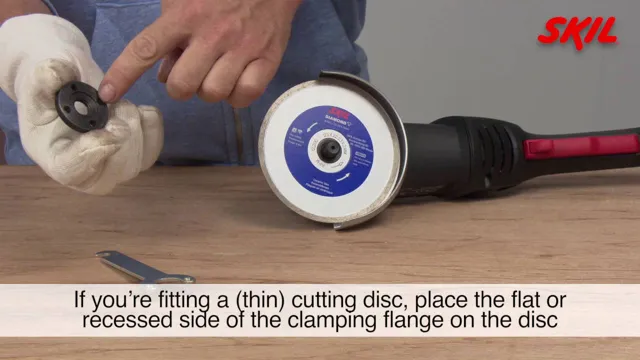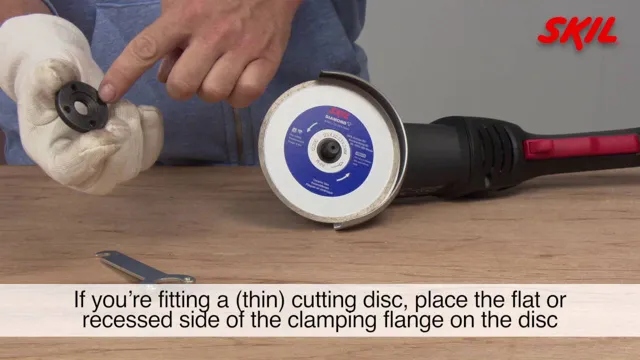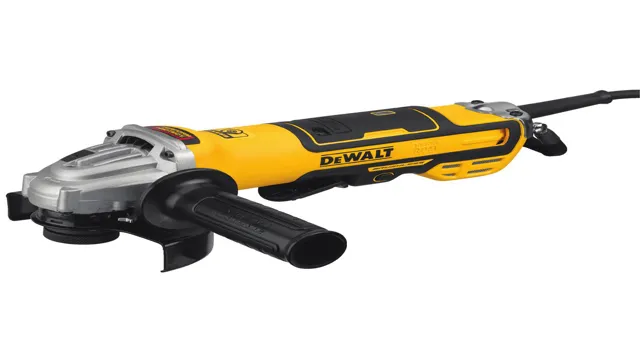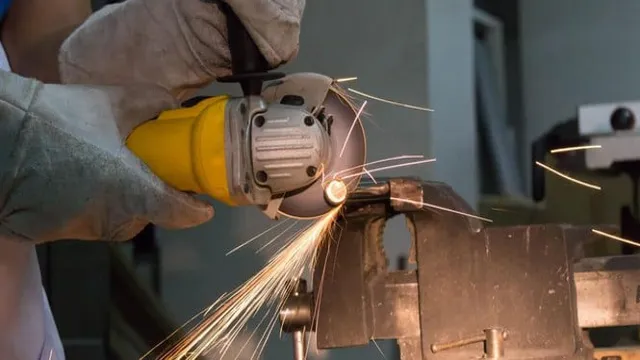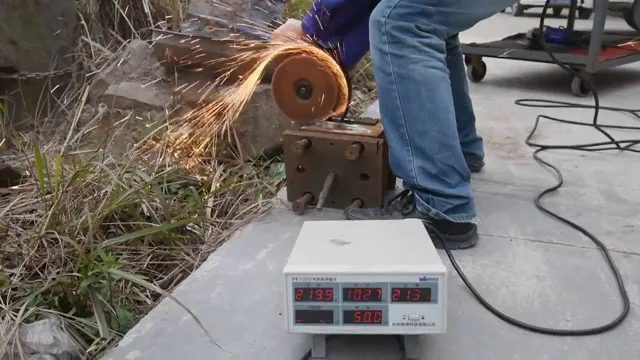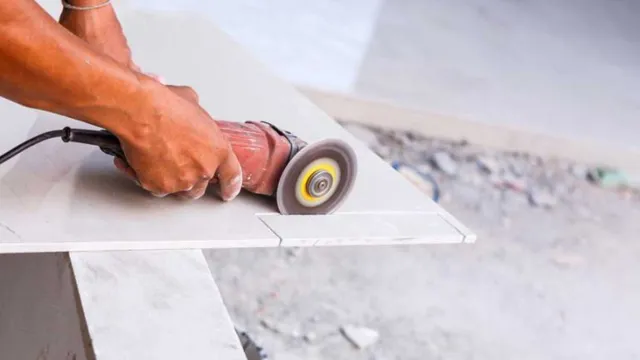How to Cut Natural Stone with Angle Grinder – A Comprehensive Guide for Beginners
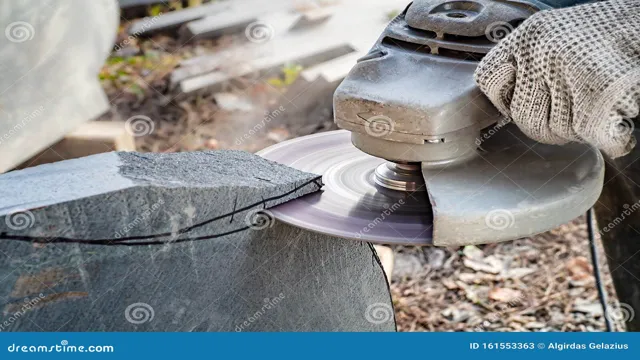
If you’re looking to DIY a natural stone project, you may be wondering how to cut those slabs down to size. While there are various tools to choose from, an angle grinder is a popular option for its versatility and affordability. However, cutting stone with an angle grinder is not as simple as slicing through butter.
It requires the right technique, safety precautions, and the right blade. In this article, we’ll provide you with step-by-step instructions on how to use an angle grinder to cut natural stone and share some tips to help you make clean and precise cuts. So, get ready to put your handy skills to the test and make your landscaping or home renovation projects a reality.
Choosing the Right Angle Grinder and Blade
If you’re planning to cut natural stone, an angle grinder can be a versatile tool that helps you achieve precise cuts. However, choosing the right angle grinder and blade is crucial to ensure safety and accuracy. The first thing to consider is the size of the grinder.
A small grinder is suitable for cutting thin stones, while a larger grinder can handle thicker ones. Secondly, pick a diamond-tipped blade since they’re durable and offer more precision when cutting. The blade’s size should match the grinder’s size, where a small grinder requires a 4-inch blade, while a larger grinder can accommodate a 9-inch blade.
It’s also vital to ensure the blade’s speed rating matches the grinder’s speed rating. Finally, always wear protective gear such as goggles, gloves, and a dust mask to protect yourself from flying debris and dust particles. With the right grinder and blade, cutting natural stone can be a breeze.
Consider the Type of Stone You’re Cutting
When cutting stone, it’s crucial to consider the type of stone you’re working with before selecting the appropriate angle grinder and blade. Different types of stone vary in hardness, density, and abrasive qualities, which can affect the equipment needed to make a clean, precise cut. For example, softer, more porous stones like travertine or sandstone require less powerful tools than dense, hard stones like granite or marble.
It’s also important to consider the thickness of the material being cut, as thinner stones often require a more delicate touch to avoid cracking or chipping. Selecting the right angle grinder and blade for the job can make all the difference in achieving the desired result with minimal damage or waste.
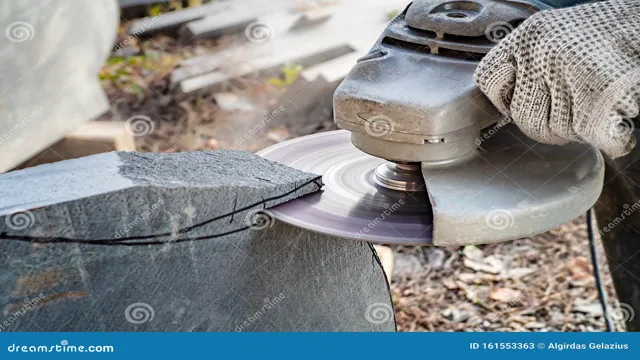
Select a High-Quality Angle Grinder
When it comes to selecting the right angle grinder, it’s important to choose a high-quality one that can handle the job at hand. Look for grinders with robust motors and durable materials that can withstand frequent use. Make sure to pair your angle grinder with the appropriate blade for the task, whether it’s a diamond blade for cutting tiles or a metal cutting disc for grinding down steel.
Keep in mind that a sharp blade is crucial for efficient and safe operation. Don’t forget to check the size and compatibility of your chosen blade with your grinder to ensure a secure fit. With the right angle grinder and blade combination, you can tackle any job with ease.
So, why settle for less when you can invest in a high-quality tool that will make all the difference?
Choose a Diamond Blade for Natural Stone
When it comes to cutting natural stone, choosing the right angle grinder and blade is crucial for achieving a clean and precise cut. Diamond blades are the go-to option for cutting natural stone as they are durable and can handle the hardness of the material. However, not all diamond blades are created equal, and choosing the right one can make all the difference in your work.
First, consider the size of your angle grinder. Make sure to choose a diamond blade that is compatible with your grinder’s size. Next, evaluate the type of natural stone you will be cutting.
Different types of diamond blades are designed for specific materials such as granite, marble, or slate. Make sure to select a blade that is suitable for the type of stone you will be working with. Another essential factor to consider is the blade’s quality.
High-quality diamond blades are designed to last longer and cut smoother than lower quality blades. Although they are more expensive initially, investing in a high-quality blade can save you time and money in the long run. Lastly, make sure to prioritize safety when using your angle grinder and diamond blade.
Always wear proper protective gear such as eye and ear protection, as well as gloves. It is also crucial to ensure your work area is clear of debris and that your blade is properly mounted and secured before starting. Overall, choosing the right angle grinder and diamond blade for natural stone cutting requires careful consideration of multiple factors such as size, type of stone, quality, and safety.
By making informed decisions in these areas, you can achieve a smooth and precise cut every time.
Preparing the Stone for Cutting
If you are ready to start your natural stone cutting project, the first step is to prepare the stone for cutting. One way to cut natural stone is by using an angle grinder. However, before you get started with the grinder, it is important to properly prepare the stone.
Start by cleaning the stone with soap and water to remove any debris or dirt that could interfere with the cutting process. Next, use a pencil or marker to trace the area you want to cut out on the stone. Make sure your lines are straight and even to ensure an accurate cut.
Once you have marked the stone, use a diamond cutting blade to make a shallow cut along your lines. This will help guide the blade and prevent it from slipping as you begin cutting deeper into the stone. Remember to always wear protective gear, including gloves and eye goggles, when cutting natural stone with an angle grinder.
With these precautions and proper preparation, you’ll be on your way to successful stone cutting.
Clean the Stone Surface Thoroughly
Before you start cutting the stone surface, it’s essential to prepare it first by cleaning it thoroughly. Dust, dirt, and debris can affect the quality of the cut, so it’s crucial to remove them all. Start by using a stiff-bristled brush to scrub the surface vigorously.
For more challenging stains or debris, you may need to use a pressure washer or chemical cleaner, depending on the type of stone. Afterward, let the stone dry completely before cutting. Preparing the stone helps ensure a cleaner cut and prevents any unwanted mishaps during the cutting process.
Don’t forget to put on protective gear like safety goggles or a face shield, so you’re protected while cutting the stone. By following these steps, you’ll be well on your way to cutting a perfectly polished stone surface.
Mark the Cutting Line with a Pencil or Chalk
When it comes to preparing the stone for cutting, the first and most important step is to mark the cutting line with a pencil or chalk. This simple task serves as your guide during the cutting process and ensures that your final product comes out exactly as you intended. Before marking the stone, make sure it’s clean and dry to avoid any errors or smudging.
Then, using a ruler or any straight edge, draw a straight line in the location where you want to make the cut. If the stone has irregular shapes or curves, draw the line gradually, connecting several points along the curve. Remember that accuracy is key, so take your time and double-check your line before making any cuts.
A confident and well-marked line will make the rest of the process go much smoother. So, take your time, prepare the stone well, and trust your gut when marking the line. With a little patience and practice, you’ll be ready to make precise cuts in no time!
Secure the Stone in Place with Clamps
When preparing a stone for cutting, it’s important to make sure it stays in place throughout the whole process. This is where clamps come in handy. By securing the stone in place with clamps, you can minimize any movement or shifting that may occur, ensuring a more precise cut.
It’s important to use the right kind of clamp for the job, such as C-clamps or bar clamps. Make sure to position the clamps in a way that won’t hinder the cutting process or get in the way of the saw. By taking the time to properly secure the stone in place, you’ll not only make the cutting process easier but also get a better end result.
Cutting the Stone with an Angle Grinder
When it comes to cutting natural stone for your DIY projects, using an angle grinder can be a great option. But how do you do it? First, make sure you have the right attachment for your grinder – a diamond wheel is the best choice for cutting through tough stone. Next, mark the area you want to cut and use a steady hand to guide the grinder along the line.
Keep the blade at a 90 degree angle and use a firm, but steady pressure to avoid chipping or damaging the stone. It’s important to wear safety gear like goggles and a mask to protect yourself from flying debris. Take your time and don’t rush the process – cutting stone with an angle grinder can be a slow and steady process, but the results can be well worth the effort.
With a little practice and patience, you’ll be able to cut natural stone with ease and precision.
Put on Personal Protective Equipment
Before starting any cutting task on stone with an angle grinder, it’s essential to put on personal protective equipment to ensure safety during the process. This means that you should wear gloves, eye protection goggles, and a face mask. Stones can produce harmful debris and dust when cut with an angle grinder, which can cause eye damage or respiratory problems when inhaled.
Wearing protective gloves also helps avoid injuries while holding the angle grinder securely. As for the cutting process itself, I recommend using the right angle grinder with the appropriate disc to ensure the best results. Remember, your safety comes first, so make sure you’re well equipped before starting any cutting task.
Turn on the Angle Grinder
Cutting stone with an angle grinder can be a bit daunting if you’re new to the DIY game. But with the right tools and precautions, it’s a simple process that can transform your outdoor space. To get started, you’ll need to turn on your angle grinder and select the appropriate cutting wheel.
Make sure to wear eye and ear protection, and take frequent breaks to avoid hand fatigue. Begin by marking your stone with a pencil or chalk to ensure a straight cut. Then, slowly guide the grinder through the stone, ensuring even pressure and movement.
Depending on the size of your stone and the depth of your cutting, you may need to make multiple passes. Once your cut is complete, use a chisel to remove any rough edges or excess material. With a bit of practice, cutting stone with an angle grinder will become second nature, and you’ll be able to create stunning outdoor features in no time.
Start by Making Shallow Cuts
When it comes to cutting stones with an angle grinder, it’s important to start by making shallow cuts. This helps to prevent the blade from getting stuck in the stone and causing damage. By gradually making deeper cuts, you can create a smooth and even surface.
Be sure to use the right type of blade for the stone you’re cutting and to keep the blade clean and sharp. It’s also important to wear safety gear, such as goggles and gloves, to protect yourself from flying debris. With some practice and patience, cutting stones with an angle grinder can be a rewarding and satisfying project.
So, the next time you need to cut some stones for a DIY project, remember to start with shallow cuts and work your way up to the desired depth.
Take Breaks to Prevent Overheating
Cutting stone with an angle grinder is a demanding task that requires both skill and patience. One of the most common problems you’ll face when using an angle grinder to cut stone is overheating. If you don’t take breaks when needed, the motor can overheat, and the grinder’s performance can decline.
To prevent this, it’s crucial to take breaks to let the tool cool down. You don’t want to damage the motor and end up having to buy a new one. Overheating is preventable by simply taking a few minutes to let the angle grinder cool down before continuing with the job.
It’s also a good idea to use a lubricant to help reduce friction and prevent the tool from overheating. Remember to take breaks, let your angle grinder cool down, and use a lubricant to make cutting stone with an angle grinder a breeze.
Gradually Deepen the Cut
When it comes to cutting stone with an angle grinder, it’s important to gradually deepen the cut. The process of deepening the cut should be done slowly and carefully, ensuring that the blade of the angle grinder is at the correct angle. Starting with a shallow cut and slowly increasing the depth will ensure that the blade doesn’t become overheated, which can cause it to warp or even break.
It’s also important to use a steady hand while cutting, so as not to accidentally cut too deeply or damage the stone. Remember, cutting stone with an angle grinder can be a tricky process that requires practice and patience. Don’t rush, take your time, and you’ll be able to achieve the perfect cut in no time.
With the right technique and the right angle grinder, you can create stunning designs and shapes in a wide range of stone materials. So, why not give it a try and see just how easy cutting stone with an angle grinder can be?
Tips for Successful Stone Cutting
If you’re looking to cut natural stone, using an angle grinder can be an effective method. However, it’s important to take certain precautions to ensure safety and success. First and foremost, make sure you are using the correct blade for the job.
A diamond blade is recommended for most types of natural stone. Next, be sure to wear the necessary protective gear, including ear plugs, safety glasses, and a dust mask. When cutting, use a firm, steady grip and make sure the blade is cutting smoothly through the stone.
It’s also important to take breaks every so often to avoid overheating the blade. Lastly, make sure to clean up any dust or debris after cutting to avoid any potential hazards. By following these tips, you can successfully cut natural stone with an angle grinder.
Take Your Time and Be Patient
If you’re looking to start stone cutting as a hobby or profession, one of the most important things to keep in mind is to take your time and be patient. Stone cutting can be a delicate and time-consuming process, and rushing through it can lead to costly mistakes and unsatisfactory results. Before you begin, make sure you have all the necessary tools and equipment and take the time to familiarize yourself with them.
When cutting, start with small, smooth motions and work your way up gradually. Don’t try to cut too deeply or quickly, as this can cause the stone to crack or break. Remember, practice makes perfect, and the more time and patience you put into stone cutting, the better your results will be.
Use a Guide for Straight Cuts
Cutting stones can be a daunting task, especially if you’re not familiar with the right technique. One important tip that can help you successfully cut stones is to use a guide for straight cuts. This can be a template or a ruler that helps you create consistent and precise cuts.
By using a guide, you can avoid mistakes and ensure that your cuts are straight. It’s also important to choose the right blade for the type of stone you’re cutting. Different stones require different types of blades, so be sure to research beforehand.
Additionally, always wear protective gear such as goggles and gloves to avoid injuries. With these tips and a little bit of practice, you can become an expert at cutting stones in no time.
Don’t Force the Blade Through the Stone
Cutting stones can be a daunting task, but there are a few things you can do to make sure you are successful. One of the most important tips to keep in mind is to never force the blade through the stone. This is because the harder the stone, the more difficult it will be to cut, and forcing the blade can cause it to become damaged or even break.
Instead, allow the blade to do the work, applying gentle pressure and letting it cut through the stone at its own pace. You may need to make multiple passes to get the desired cut, but taking your time will ultimately lead to better results. Remember, patience is key when it comes to stone cutting!
Be Mindful of the Dust and Debris
When it comes to successful stone cutting, there are a few crucial things to keep in mind. One of the most important is being mindful of the dust and debris that results from the cutting process. Stone dust can be harmful to both your health and the environment, so it’s important to take steps to minimize its impact.
This might include setting up a dust collection system or using a wet cutting method to help reduce airborne particles. Additionally, it’s important to wear the appropriate personal protective equipment, like a respirator mask and safety glasses, to help protect yourself from potential health hazards. By taking the time to be mindful of the dust and debris that result from stone cutting, you can not only ensure a successful project but also stay safe and keep the environment around you healthy.
Conclusion
Cutting natural stone with an angle grinder is not as daunting as it sounds, especially with the right tools and careful technique. While it may seem like a Herculean task, you can achieve precise cuts with a steady hand and a little patience. Remember, a diamond blade is your best friend and taking the time to measure and mark your stone will save you from costly mistakes.
So go ahead, tackle that natural stone with confidence and finesse, and soon you’ll have a work of art that will make Michelangelo proud!”
FAQs
What type of blade should I use to cut natural stone with an angle grinder?
A diamond blade is recommended for cutting natural stone with an angle grinder.
What safety precautions should I take when cutting natural stone with an angle grinder?
Always wear safety glasses and protective gloves when using an angle grinder. Also, make sure the stone is securely clamped down before cutting.
Can I use water to cool the blade while cutting natural stone with an angle grinder?
Yes, using water to cool the blade can help increase its lifespan and prevent the stone from cracking.
What is the ideal speed for cutting natural stone with an angle grinder?
The ideal speed for cutting natural stone with an angle grinder is between 5,000 and 6,000 RPM.
Should I make multiple shallow cuts or fewer deeper cuts when cutting natural stone with an angle grinder?
It is recommended to make multiple shallow cuts rather than fewer deep cuts in order to reduce the risk of overheating the blade and potentially cracking the stone.
What types of natural stone can be cut with an angle grinder?
An angle grinder can be used to cut many types of natural stone, including granite, marble, and sandstone.
How do I maintain my angle grinder blade when cutting natural stone?
Make sure to clean the blade after each use and check for any signs of wear or damage. It is also recommended to regularly sharpen the blade to maintain its cutting effectiveness.

